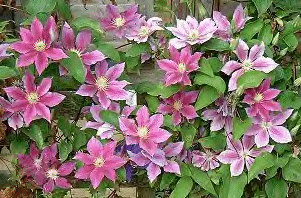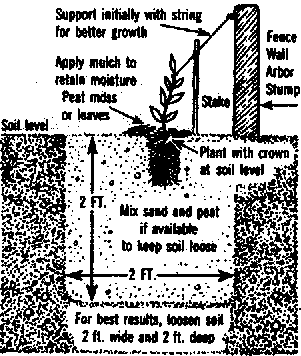ABOUT VINES
How many uses and purposes in the landscape? Properly situated, a vine can beautify an ugly view, divide a garden, shade a patio, make a windbreak, provide privacy, etc.
Evergreen vines are limited in variety but not in diversity.
Carolina Jasmine (Gelsimine) - A moderate size evergreen vine with dark green foliage all year. Caution should be used with small children as parts of the plant are poisonous. Does best with 5 hours or more sun. Needs good moisture the first year. A mulch is helpful. Bright yellow fragrant blooms in April.
Purpurea Honeysuckle (Lonicera) - Very hardy fast growing vine with purplish foliage in winter and fragrant pink and white flowers intermittently all summer. Can be used as ground cover or a free standing bush to 30" tall.
English Ivy (Hedera) - Aristocrat evergreen vine for brick, rock, or wood walls and fences. Deep green foliage year around. Slow growing first year, but faster after that. Does best on North or East side. Can be used as ground cover in shade or part sun.
Deciduous Vines (Not Evergreen)
Chinese Bittersweet - Hardy easy to grow vine for sun or part shade with long lasting orange berries through winter. Plant two for better berry production. For trellis or fence or fee standing bush.
Boston Ivy - Attractive vine for brick or wood walls. Will grow to top of two story house. Bright red fall color. For sun or shade.
Boston Ivy (Beverly Brooks) - Not as large a leaf or vine as above. Good for smaller space.
Grapes - Can be used as a decorative vine for arbors or fences. Fruit can attract bees and wasps if not picked.
Gold Flame Honeysuckle - Intermittent blooms spring and summer. Can be used as a vine or bush. Large yellow and coral blooms, not fragrant. Attractive to Hummingbirds. Good for sun or part shade.
Scarlet Trumpet - Gorgeous 2" coral red flowers in April and May. Not fragrant. Grows to 15 feet. Attractive to Hummingbirds. Good for sun or part shade.
Wisteria Purple - Large vine 20'-30'. Needs good support such as chain link fence. Very fast growing. Do not fertilize as this inhibits flowering. Fragrant purple pendulous clusters of blooms in May and June. Prune immediately after blooming to keep size and shape. Thin out runners two feet apart and prune remainder back. Can be trained to tree shape by staking and trimming. Sometimes available in white and pink.
Trumpet Vine (Campis)
Very hardy vigorous growing vine for large areas. Will take over if not controlled. Spectacular orange red blooms in midsummer.
![]()
CLEMATIS

THE QUEEN OF ALL FLOWERING VINES
Clematis are hardy, easy to grow, and spectacular in bloom. Do not be impatient as it takes 2 to 3 growing seasons to grow a good size vine.
These gorgeous plants can be used on trellises, archways, tree stumps, utility poles, mail box posts, plus many other uses.
PLANTING
Planting is best done in Fall, Winter, or Spring with plants started in one gallon containers. The vine should receive 5 hours or more of sunlight. Clematis make a deep root system. The soil should be loosened at least 2' deep and wide. Mix 4 or 5 gallons peat moss in each hole: a quart each of Gypsum and Lime is beneficial, if available. Mix all thoroughly with soil. Plant so ground level is the same as soil in the pot. It is best to have the trellis or other support in place before planting as growth is rapid in April and May. A small stake may help support the vine until it becomes attached to permanent support.
CARE
Water well when planted and weekly as needed. Twice weekly in summer. Mulch with cottonseed hulls, bark, or longhorn manure as soon as planted. Keep manure away from stem. Do not use manure after May 1st. Feed spring and fall with a rose food or 10-20-10.
PRUNING
Pruning can be done in early spring after the first season. After new buds are visible, prune out dead wood and shape vine lightly. Heavy pruning is usually not needed. Do not cultivate around vine and be careful not to injure stem at ground level as this can allow disease to enter. A small annual such as alyssum or rose moss can be planted around base. Larger ones such as petunia should be avoided. Extra care the first year or two will establish a good root system for a healthy plant for many years.

USES:
![]() Frame
porches
Frame
porches
![]() Cover
rock piles
Cover
rock piles
![]() Glorify
trelisses
Glorify
trelisses
![]() Adorn
light poles
Adorn
light poles
![]() Frame
entranceways
Frame
entranceways
![]() Hide
unsightly views
Hide
unsightly views
![]() Beautify
tree stumps
Beautify
tree stumps
![]() Decorate
fences or stone walls
Decorate
fences or stone walls
![]() Combine
with climbing roses, shrubs, or use alone
Combine
with climbing roses, shrubs, or use alone
![]() Use
anywhere you want a color highlight
Use
anywhere you want a color highlight
![]() Finally,
flloat the lovely blooms in a bowl of water or arrange other ways in your
home
Finally,
flloat the lovely blooms in a bowl of water or arrange other ways in your
home